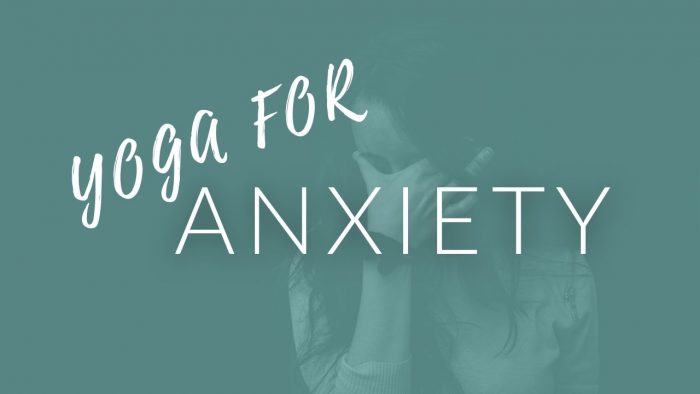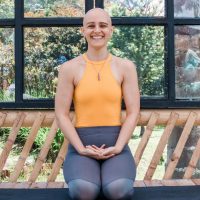YOGA FOR ANXIETY
Mind-body practices such as yoga are especially beneficial to people struggling with anxiety disorders. This practice can alleviate everything from anxious thoughts to an overactive nervous system.
Continuing our series on yoga for mental health, this week we’re exploring yoga and anxiety. Read on to learn how these disorders develop and how yoga can help.
What exactly is anxiety?
Our nervous system is made up of two parts: the central nervous system and the peripheral nervous system. The peripheral nervous system consists of everything besides the brain and spinal cord and includes what’s known as the autonomic nervous system (ANS). The ANS is further divided into two systems: sympathetic and parasympathetic.
The sympathetic nervous system is where our “fight or flight” response comes from. This response occurs in the face of stressful, dangerous, or unfamiliar situations. It floods the body with glucose for energy, diverts blood from the organs to your muscles, and increases the heart rate – all in an effort to prepare your body to respond to a given threat.
The flight or fight response is an important aspect of human survival. While it’s intended to help us survive threats, chronic stress and overwhelm can cause overactivation of that system. An overactive sympathetic nervous system is thought to be one of the underlying causes of an anxiety disorder.
Individuals with an anxiety disorder experience that fight or flight response on a level that interferes with their daily life. It can cause symptoms such as rapid breathing, heightened heart rate, restlessness, insomnia or trouble sleeping, negative thoughts and feelings, and difficulty concentrating. These symptoms affect your general wellbeing and, in some cases, are debilitating.
Yoga and anxiety
Yoga is an ancient practice that has become increasingly popular in our western world. It’s well-known as a practice that improves balance, increases physical strength, and enhances flexibility. But more than that physical practice, yoga is a mind-body practice with a number of non-exercise components.
Those components include breathwork, meditation, and relaxation and they’re a big part of the reasons that yoga helps anxiety. Below, we explain how yoga for anxiety works on your nervous system, thoughts, mood, and even physical tension.
Yoga to Calm the Nervous System
As we explained above, the sympathetic nervous system plays a key role in the development of anxiety disorders. But it’s the other component of the ANS, the parasympathetic nervous system, that’s of special interest to those using yoga for anxiety.
If the sympathetic nervous system is responsible for the “fight or flight” response, the parasympathetic nervous system is responsible for our “rest and digest” response. This system restores the mind and body to homeostasis following a fight or flight experience.
Yoga is an incredible way to calm the nervous system. By practicing yoga, we unconsciously learn how to tap into our parasympathetic nervous system through a focus on breath, or pranayama.
Yoga encourages individuals to be aware of their breath not just in the meditation and relaxation portions of a class but also throughout the practice while moving from pose to pose. Research shows that just being aware of breath increases the activity of the parasympathetic nervous system.
Yoga also encourages deep, conscious breathing. Breathing in a way that involves equal inhales and exhales, we tone our vagus nerve. This, in turn, sends a signal to activate the parasympathetic nervous system.
Those breathing practices develop into habits over time. Individuals who practice yoga can eventually tap into their breath to calm sympathetic nervous systems responses and the accompanying symptoms of anxiety.
Try this yoga practice to calm your nervous system.
Yoga For Anxious Thoughts
Anxiety can cause – and is caused by – worry about future events. When your mind is full of worry about things that could happen, it can cause other symptoms, such as difficulty sleeping or a loss of appetite.
Alleviating worry about future events means learning to be present in the moment. It’s the meditation component of yoga that harnesses the power of thought and assuages anxious thoughts about the future. Meditation strengthens your mind’s ability to recognize worrying thoughts and prevent them from developing.
Through meditation, we also learn to identify what thoughts and situations trigger our anxiety, how to sit with those thoughts, and how to let them go. Eventually, we come to see that our thoughts aren’t real, they don’t define us or how we feel. Armed with the ability to question the narratives that lead to symptoms of anxiety, you can rewire your neural pathways and your response to situations and thoughts that trigger anxiety.
Suggested grounding meditation.
Yoga to Improve Your Mood
Gamma-aminobutyricacid (GABA) is a neurotransmitter. It sends chemical messages through the brain and nervous system and regulates communication in different systems of the body. But the activity of GABA in individuals with anxiety disorders is far less than in those without these conditions.
Studies have found that practicing yoga postures has a direct effect on GABA levels. And the consequences of increased GABA levels include everything from a decrease in anxiety to an improvement in overall mood.
Yoga and Releasing Physical Tension
When our bodies are under stress or feeling anxious, our muscles constrict. When we’re under a constant state of anxiety, that excessive constriction sends subconscious messages to our mind that we aren’t at ease. This results in physical symptoms such as tension, tightness, and pain sensitivity in our shoulders, neck, jaw, and elsewhere.
Moving through yoga postures can stretch and lengthen constricted muscles. Stretching and lengthening releases built-up tension from the body, and a regular practice makes those changes more permanent.
Treating Anxiety With Yoga
Some people notice the effects of yoga immediately. After one class, they have noticeably reduced anxiety. But if you’re looking for a long-term solution, a consistent yoga practice is key.
With consistent practice, you learn how to tap into the tools you’ve learned in yoga when you encounter destressing or anxiety-inducing situations off the mat. Contact me to begin your journey using yoga for anxiety.







Read 0 comments and reply